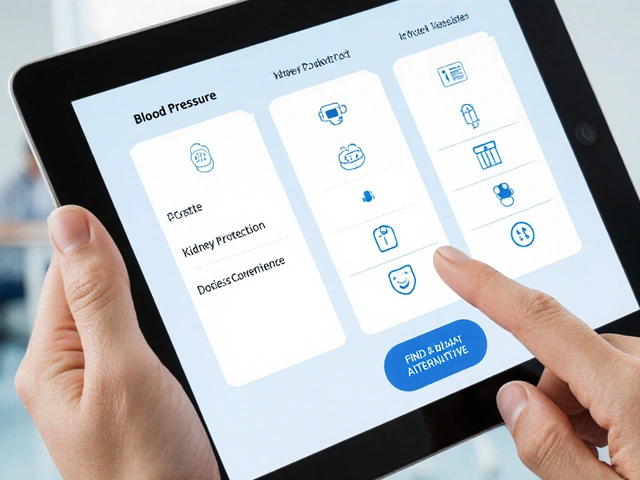Varenicline Treatment Duration Calculator
Personalized Treatment Duration Guide
This tool estimates your optimal Varenicline treatment duration based on key factors. Your healthcare provider should review the results before making any changes to your treatment plan.
If you’ve tried cutting back, using patches, or simply “willpower” and still end up with a cigarette in hand, you’re probably wondering: treatment duration matters. How many weeks of Varenicline a prescription medication that targets nicotine receptors to blunt cravings and withdrawal symptoms do you really need to quit for good?
How Varenicline Works
At its core, Varenicline acts as a partial agonist at the α4β2 nicotinic acetylcholine receptor. That means it “tricks” the brain into thinking nicotine is present, easing cravings, while also blocking actual nicotine from fully activating the receptor. The result is a double‑hit: fewer urges and a muted high if you slip. The drug’s half‑life is about 24 hours, which is why the standard regimen is a once‑daily tablet after an initial titration period.
Standard Recommended Treatment Length
Regulatory bodies such as the FDA the United States Food and Drug Administration, which approves medications and sets labeling guidelines and the WHO World Health Organization, which publishes global tobacco‑control recommendations both list 12 weeks as the default course. The schedule typically looks like this:
- Days 1‑3: 0.5 mg once daily (to gauge tolerance).
- Days 4‑7: 0.5 mg twice daily.
- Day 8 onward: 1 mg twice daily for the remaining weeks.
After the 12‑week block, many clinicians suggest an additional 4‑week “maintenance” period for people who have reduced smoking but still experience occasional cravings.
Factors That Influence How Long You’ll Need It
Not everyone quits in exactly 12 weeks. Several variables can push the timeline longer or allow a shorter stint:
- Nicotine dependence level - Measured by the Fagerström Test for Nicotine Dependence, scores ≥ 6 often need the full 12‑week regimen plus maintenance.
- Previous quit attempts - Re‑starting treatment after a lapse may benefit from a fresh 12‑week cycle.
- Concurrent Nicotine Replacement Therapy products like patches, gum, or lozenges that deliver low‑dose nicotine - Combining NRT for the first two weeks can smooth the transition, but may also shorten the overall Varenicline exposure.
- Side‑effect tolerance - If you develop severe nausea or vivid dreams, clinicians sometimes pause after 6 weeks and resume later.
Understanding these factors helps you and your prescriber decide whether a 6‑week “starter” makes sense or whether you should commit to the full protocol.
Shorter vs. Longer Courses: What the Evidence Says
Multiple clinical trial randomized studies that evaluate efficacy and safety of medications data point to a clear pattern: quitting success climbs sharply between weeks 4 and 12, then plateaus. A 2019 meta‑analysis of 14 trials (over 8,000 participants) reported a 44 % abstinence rate at 12 weeks versus 30 % at 6 weeks. However, a 2022 real‑world cohort from the UK NHS found that patients who stopped Varenicline at 8 weeks but continued behavioral support still achieved a 38 % quit rate at 6 months, compared with 41 % for those who completed 12 weeks. The difference wasn’t statistically significant, suggesting that a well‑structured support program can compensate for a truncated medication course.
Managing Side Effects Over Time
Side effects usually appear in the first two weeks and taper off. Common issues include:
- Nausea - Affects ~30 % of users; taking the tablet with food often helps.
- Sleep disturbances - Vivid dreams peak around week 3; shifting the dose to the morning can reduce them.
- Headache - Usually mild and resolves by week 4.
If symptoms linger beyond week 6, discuss dose reduction or temporary interruption with your doctor. Most people who persist with the full schedule report a net benefit outweighing the discomfort.
How Varenicline Stacks Up Against Other Quit Aids
| Metric | Varenicline | Nicotine Replacement Therapy (NRT) | Bupropion |
|---|---|---|---|
| Typical Treatment Length | 12 weeks (±4‑week maintenance) | 4-12 weeks (varies by product) | 7-12 weeks |
| Success Rate (6‑month abstinence) | ≈44 % | ≈30 % | ≈35 % |
| Common Side Effects | Nausea, vivid dreams, insomnia | Irritation, throat soreness, skin rash (patch) | Insomnia, dry mouth, seizure risk (rare) |
| Prescription Required | Yes | No (over‑the‑counter in many countries) | Yes |
When you line these up, Varenicline’s longer, fixed schedule gives it a statistical edge, but the choice often hinges on personal tolerance and access.

Practical Tips to Stay on Track
- Set a quit‑date that aligns with the start of the 1 mg twice‑daily phase - this is when cravings dip the most.
- Pair the medication with a behavioral program (phone counseling, apps, or group meetings). Studies show a 10‑15 % boost in success when combined.
- Keep a symptom diary for the first six weeks; note any nausea patterns and adjust meal timing.
- Use a backup Nicotine Replacement Therapy to manage breakthrough cravings without restarting smoking during the first two weeks if needed.
- Plan a “celebration” after week 12 - a reward reinforces the habit loop and helps you transition off the pill.
When to Stop: Signs You’re Ready to Discontinue
Most clinicians advise a gradual taper after the main 12‑week block. You can consider stopping outright when you meet at least two of these criteria:
- Zero cigarettes for the past 30 days (verified by breath CO test if possible).
- Cravings are mild and manageable without medication.
- Side effects have subsided and you feel no withdrawal rebound during a 2‑week medication‑free trial.
If you slip after stopping, restart the medication (most guidelines allow a second 12‑week course) and lean heavier on counseling.
Frequently Asked Questions
How long does Varenicline stay in my system after I stop?
Because its half‑life is about 24 hours, it usually clears within 5-7 days after the last dose, though trace amounts can linger a bit longer in patients with kidney impairment.
Can I use Varenicline while pregnant or breastfeeding?
Both the FDA and the WHO advise against it unless the benefits clearly outweigh potential risks. Always discuss with your obstetrician.
Is it safe to combine Varenicline with nicotine patches?
Combining them can increase nausea and headache risk. Some clinicians use a low‑dose patch for the first two weeks, but it should be done under close medical supervision.
What should I do if I miss a dose?
Take the missed tablet as soon as you remember, unless it’s less than 8 hours later - then skip it and resume your regular schedule. Never double up.
Can I switch from Varenicline to another quit aid?
Yes. A common approach is to finish the Varenicline course, then start a nicotine patch or gum for a month of maintenance. Coordination with your doctor ensures safe timing.






Comments
Vikas Kumar
October 23, 2025 AT 13:32 PMI’ve been trying to quit for ages and the idea of a 12‑week Varenicline plan feels like a marathon nobody in our country wants to run, especially when the pharma giants keep pushing pills while ignoring our own traditional herbs. The government should fund more local cessation programs instead of letting Big Pharma dictate the timeline. Still, if you’re set on the drug, stick to the full course – half‑measures just feed the addiction.
Heather ehlschide
November 1, 2025 AT 15:26 PMThe bottom line is that Varenicline’s 12‑week regimen has solid evidence behind it, so you shouldn’t arbitrarily chop it short unless you have a compelling medical reason. In the first week you’ll notice the dose is tiny – 0.5 mg – which is meant to gauge tolerance, and many people report mild nausea at this stage. By the second week you double the dose, and the brain starts receiving enough partial agonist signal to blunt the nicotine cravings noticeably. Around day eight, when you hit the full 1 mg twice daily, the medication begins to create that “blockade” effect that makes any smoked cigarette feel flat and unsatisfying. Studies consistently show that quit rates climb sharply between weeks four and twelve, with a 44 % abstinence rate at the 12‑week mark compared to roughly 30 % at six weeks. That plateau after week twelve suggests that most of the neuro‑adaptation happens early, but the maintenance phase helps solidify the new habit. If side effects like nausea or vivid dreams become intolerable, many clinicians will pause after six weeks and restart later, but this should be a shared decision with your prescriber. It’s also worth noting that combining a low‑dose nicotine patch for the first two weeks can smooth the transition, though it may increase nausea slightly. Your personal dependence level matters a lot – a Fagerström score of six or higher usually warrants the full protocol plus the optional four‑week maintenance. If you’ve had multiple failed quit attempts, treating the next effort as a fresh 12‑week course is often beneficial. Behavioral support – whether through counseling, apps, or peer groups – adds roughly a ten to fifteen percent boost to success, so don’t skip that component. Keep a symptom diary for the first six weeks; tracking when nausea spikes can help you adjust meal timing or consider a dose reduction. When the 12‑week block is done, assess whether you’ve met two of the three criteria for tapering: zero cigarettes for 30 days, mild manageable cravings, and no rebound withdrawal in a two‑week drug‑free trial. If you slip after stopping, you can safely restart another 12‑week cycle under medical supervision. Finally, celebrate your milestones – a small reward after week twelve reinforces the habit loop and makes the transition off the pill feel like a victory rather than a loss.
Kajal Gupta
November 8, 2025 AT 14:06 PMThanks for the thorough rundown, I totally agree that the behavioral component is often the missing piece many overlook; it’s like adding the spice to a bland dish, you know the recipe is solid but you still need that extra flavor to make it sing. From my experience, pairing a low‑dose patch for the first ten days while on Varenicline helped my stomach settle, and the colorful progress chart I kept made the whole process feel like an art project rather than a clinical trial. If anyone’s wondering about the timing, I’d suggest syncing the quit‑date with the start of the 1 mg twice‑daily phase – that’s when the craving dip is most noticeable, and it gives your mind a clear “off‑switch” cue. Also, don’t forget to breathe deeply during those vivid dream nights; a short meditation can calm the mind and reduce the intensity. Keep sharing your insights, we’re all in this together!
Zachary Blackwell
November 17, 2025 AT 20:20 PMWhat they don’t tell you is that the whole “12‑week” label is a marketing ploy cooked up by the pharmaceutical lobby to lock you into a profit cycle; the real data shows you can achieve comparable quit rates with just eight weeks if you ditch the extra pills and rely on natural dopamine boosters. The FDA’s guidelines are essentially a rubber‑stamp for Big Pharma’s pricing strategy, and the “maintenance” phase is just a way to keep you on the drug longer while the side‑effects quietly chip away at your mental clarity. If you’re savvy, look at the older nicotine‑replacement studies – they often outperformed Varenicline when you factor in cost and long‑term health. In short, don’t be a guinea pig for a ten‑year‑old corporation’s profit machine; explore holistic alternatives and keep the drug‑company’s hand off your brain.
prithi mallick
November 24, 2025 AT 19:00 PMi totally get that feeling of being pulled in different direction – it’s like the mind is a river that keeps trying to find its own path while the currents of pharma push you downstream, but remember that every step you take toward awareness is a victory; we can think of the 12‑week course as a bridge that you can walk across and then step off when you feel steadier, not a chain that binds you forever. i feel you on the side‑effects, they can be gnarly, but a supportive circle, maybe a friend or a coach, can help you watch the pattern and adjust timing, like moving the dose to morning if dreams get too vivid. hold onto hope and keep noting how your body reacts – those tiny clues are the compass you need. you’re not alone in this, many have walked the same road and found the light at the end.
Michaela Dixon
December 4, 2025 AT 01:13 AMI started Varenicline after my third failed cold turkey attempt and honestly it felt like stepping into a foggy forest where every path looked the same yet the guide promised you would eventually find a clearing the dosage schedule was laid out like a road map starting with a half pill a day for three days then doubling up and finally reaching the full two a day and I followed that to the letter my stomach rebelled at first with a wave of nausea that seemed to last longer than any movie I’d ever watched but by the end of week two the feeling faded like a bad dream I kept a notebook where I scribbled every craving moment and the time of day and I noticed a pattern that most cravings hit right after lunch which made sense because my body associated meals with nicotine breaks I also paired the medication with a light exercise routine of short walks after dinner and it helped distract my mind and lower stress levels the side effects that lingered past week six were mainly vivid dreams that made me wake up at odd hours but shifting the dose to the morning stopped those nocturnal adventures completely the key takeaway for me was that the 12‑week period isn’t just a number it’s a structured support system that gives your brain time to rewire and your habits a chance to reset in addition I found that the optional four‑week maintenance acted like a safety net especially on those tough social gatherings where the urge to smoke feels stronger I’d recommend anyone on this journey to talk openly with their doctor about any side effects and not just push through because the goal is a sustainable, healthy change not just a quick fix I also explored a short breathing exercise app that helped me manage anxiety during cravings and it blended well with the medication regime overall the experience taught me patience perseverance and the importance of combining medical treatment with personal habits for lasting success
Dan Danuts
December 10, 2025 AT 23:53 PMGreat job sharing that roadmap! It’s awesome how you turned the schedule into a real plan and added walks and a diary – those little wins keep the momentum going. Keep that energy up and remember every day without a cigarette is a point on the scoreboard, you’ve already earned so many points just by sticking to the 12‑week rhythm. Keep pushing, you’ve got this!